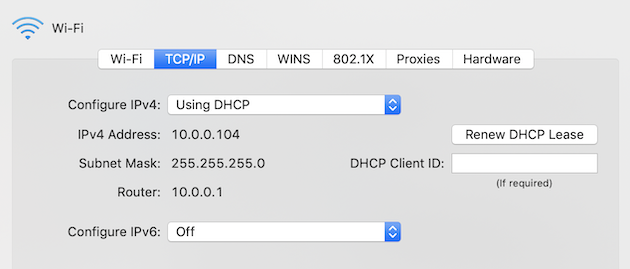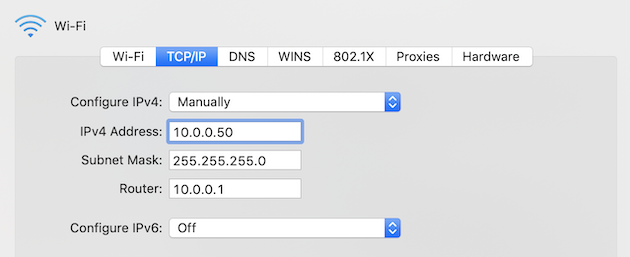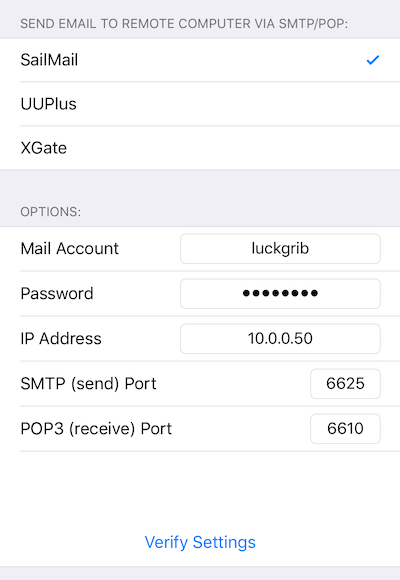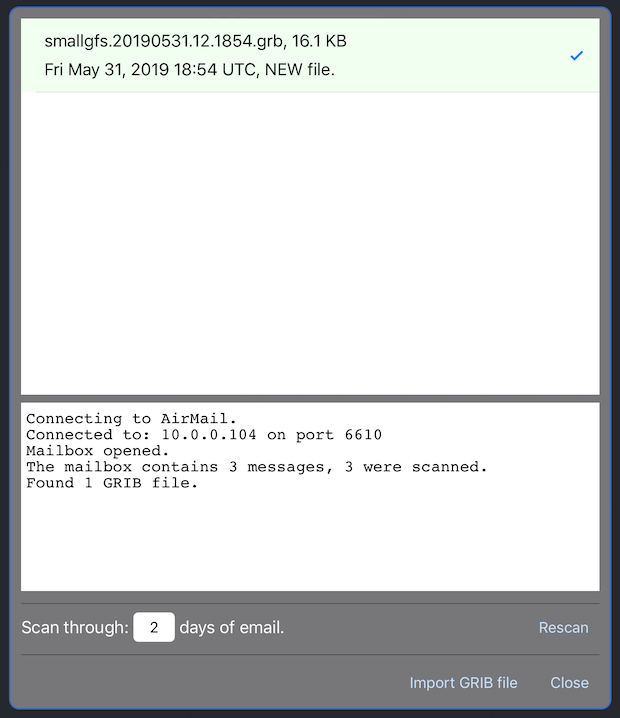SailMail / iOS
To use SailMail from LuckGrib on iOS, you will need access to a computer running Airmail. In this scenario a Windows virtual machine has been created on a Mac. With that in place, you will do the following:
- establish a WiFi network. Connect your iPhone/iPad to the network along with the computer running Airmail.
- configure LuckGrib to send its email requests directly to Airmail in the virtual machine
- send and receive mail using Airmail in the normal way.
- retrieve the weather data from the newly received email, using the LuckGrib POP3 interface.
These steps will be described in more detail.
(Or course, if you have a Mac you can simply purchase LuckGrib for it and avoid this complexity. However, this scenario also works, slightly modified, to use Airmail running on a Windows laptop.)
Establishing a WiFi network - travel router
In order to make this scenario work, we want LuckGrib on one device to talk to an email program on a different device. In order for the devices to be able to talk to each other they must be connected to the same WiFi network.
This is typically easy when you are on shore, as normally all of our devices are on the network all the time.
However, the problem we want to solve is to make this work while we are out in the middle of nowhere, on a boat far from shore. Imagine you are using an iPad to study the weather and have access to SailMail running on a computer. In order for your iPad to be able to communicate with your computer, they both need to be on the same WiFi network. The first step in this process will be to create a WiFi network for them to share.
One way of doing this would be to purchase a travel router. These routers are typically small, power efficient, and inexpensive. If you buy one that is powered via a USB connection, then providing it power will be easy onboard a sailboat.
One source for Travel Routers is through Amazon. Try searching for something like “USB powered travel router”
You will want to work through this process while you have easy access to retail outlets (such as Amazon) and are also able to use the powers of the internet to research different solutions.
Once you have a router, follow its instructions to set it up. There will be no need for the router to access a network itself - the purpose of the router will be for it to provide a network to share.
Once the router is plugged in and turned on, connect the devices to the network it is providing. These devices are now able to talk to each other.
Note: if you simply want to test the Offshore service, you can skip this step. If both devices you are testing are connected to the same network, that is sufficient.
Thanks to: Thank you to David Burch for being the first to let me know about this technique for exchanging files while offshore.
WiFi network - IP Addresses
Once a WiFi network has been established and the two devices you want to be able to talk to each other are sharing the network, there is one remaining step required before you can configure LuckGrib to use UUPlus: you need to know the IP address of the computer so that the client can find it.
In this scenario, there are two devices involved (although there could be more.)
- the server. This is the machine which is running the mail application you are trying to access. This could be a Mac running UUPlus.
- the client. This is where the email request is coming from. One example of a client is an iOS device that you are using to study the weather while obtaining the data through another computer.
When leaving for a offshore passage, when working this way, you will probably want to switch the server to use a static IP address. This means that its IP address will be static, and you will not need to update the address in LuckGrib running on the iPad each time they both connect to the shared network.
To access this setting:
- first, open the macOS System Preferences
- open the Network settings
- click on Advanced
- click on the TCP/IP tab
At this point, you will see a window something like the following:

Make a note of the IP address, which in this case, is 10.0.0.104.
Note: if you are simply testing the Offshore service and do not have a travel router, as described above, then you do not need to switch to static IP addressing. Simply use the IP address showing in the Network settings, as shown above.
To continue configuring the static IP address for the travel router, switch the Configure IPv4 option to the setting: Manually
Now you need to choose a static IP address for this machine. Use the first three numbers from the IP address noted above (which in this example was 10.0.0), and then for the last number, choose something like 50.

Accept these settings and continue.
Configure LuckGrib to use the SailMail SMTP / POP3 interface
Before proceeding, ensure that the Windows virtual machine is running, and that the Airmail program is also running. Airmail should be showing two windows, one for its main interface, and one for the POP3/SMTP server.
Open LuckGrib on the iOS device. Then open the Library / Settings area, and tap on the Download Method row. Tap on the Email download method, scroll down, and then tap on the SailMail client. Again, scroll down.
If you followed all of the suggestions in the macOS virtual machine configuration guide, you will configure the following:

- click on the SailMail option
Enter the following:
- account:
luckgrib(or whatever Airmail POP user you used.) - password:
luckgrib(or whatever Airmail POP user password you used.) - ip address: the IP address for the Mac running the virtual machine. (See the section of this guide discussing IP addresses.)
- SMTP port:
6625(this is the value suggested in the virtual machine guide.) - POP3 port:
6610(this is the value suggested in the virtual machine guide.)
Before proceeding, press the Verify Settings button. This will test your settings with the Airmail application.
If the Verify Settings process fails, there may be several reasons. Ensure that Airmail is running, that the POP and SMTP servers are active (there will be a window shown which indicates that the servers are waiting for connections), ensure that the virtual machine is setup to forward connections to local ports correctly, and that the Windows firewall is setup properly.
Using LuckGrib to send/receive email through SailMail
After setting up these settings, when you send email from LuckGrib to Airmail, the email request will show up directly in the Airmail Transit queue. Seeing this work the first time is very cool!
After creating the email request, use Airmail in the standard manner and have it send the email and then receive the reply.
When you receive a new email message containing weather data, press the import button:

After clicking that button, LuckGrib will use POP3 to open the Airmail mail spool, scan the messages it contains looking for weather data, test to see if that data has already been imported or not, and present you the list of files it has found:

Click on the Import GRIB file button to import the file and finish this process.
(You can import files from Airmail whenever you want. To do this, open the Files area of the Library, tap the New File button, and then tap the Import from Airmail choice.)